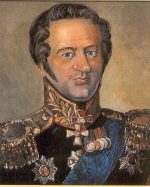The directory «Plots of stamps in the catalogue»
Zasyadko (Çàñÿäêî) Aleksander Dmitrievich
(1779—1837)

The outstanding Russian expert in the field of artillery and rocket engineering was born in 1779 in the family of Malorossian (Ukrainian) noblemen in the village of Lutenka in the Gadjachskiy district of the Poltava region. When a child Alexander was brought up at home, studied the Psalter as it was accepted in Malorossia then, played with other children and did not think at all of the future. However, his parents had thought about it for him and sent Alexander and his brother Daniil to learn at the St. Petersburg Artillery and Engineering Shliakhetsky military school in 1789. In 1797 Zasyadko finished school as a second lieutenant of artillery and was appointed to the 10th artillery battalion billeted in the Kherson region of the Ukraine. The young officer devoted all his free time to studying various scientific disciplines, and improved himself in foreign languages and also read much. But the agitated situation in Europe after the French Revolution prevented Zasyadko from continuing his education. In 1799 in the army under command of field marshal Alexander Suvorov he was sent “to rescue tsars”. The next 15 years of Alexander’s biography are full of military feats which were made all over again by Lieutenant Zasyadko, then Captain Zasjadko and, at last, full Colonel Zasyadko.
Here are the brightest episodes of his military career:
1799 - For the bravery shown at a capture of the Italian fortress Mantua field marshal Suvorov promoted him captain;
1806 - For participation in opposed landing to Ionian Islands awarded with order;
1812 - Participated in the Borodino fight (decisive battle of the Patriotic War 1812);
1813 - For heroism and distinction in the “Fight of Peoples” at Leipzig was awarded with St. George's order 3rd degree;
1814 - “For bravery and wounding in his left knee” in campaigns and battles against the French armies he was awarded with a gold sword.
On returning from France, Zasyadko's brigade was billeted in Podolia, Ukraine, and he had an opportunity again to engage in a science. On those years so-called “Congreve’s” rockets created by the English Colonel Congreve were of great interest among the Russian militaries. They knew about their efficiency in fights in Europe, but the British kept secret the "know-how" of such weaponry. Zasyadko witnessed the use of those rockets in the Battle of Leipzig, became extremely interested in them and charged himself with arming the Russian army with such rockets. In 1815 he started working on the creation of a rocket weapon using his own money having sold a manor near Odessa. In one year the secret of “Congreve’s” rockets had been revealed. To get it Alexander had to repeat all Congreve had done before. But the result was very pleaseing and very satisfactory: Zasyadko created incendiary and shell combat missiles of 2-, 2,5- and 4-inch calibre. The maximum range of such missiles was 2300 metres.
In 1817 Alexander reported to the Military Department with the description of his invention. The ease, cheapness and unusual convenience in transportation of rockets was specified in the document, the recommendations for application of new weapon were given there too. The official report was passed to the Russian Emperor Alexander the 1st who was pleased with unselfishness of the inventor and exclaimed: “Thank God! There are still officers in the Russian army who serve only for honour! ”
In 1818 Zasyadko was promoted to the rank of general-major for merits before fatherland and continued his service in the south of the Russian empire. In 1820 two important events happened in Alexander’s life: in the summer he got married to Elizaveta Gresser, daughter of the Governor of Odessa and on 25th November by the highest decree he was appointed commander of the newly established Artillery school at St.Petersburg. Also he was charged with the management of the St. Petersburg arsenal, pyrotechnic laboratory and Okhtensk gunpowder factory. Though Zasyadko occupied several posts at once, the Artillery school became his main concern : he vigorously participated in the construction of the school’s building, bought the necessary equipment, created school’s library. The subject of “rockets” was included in the curriculum and the rocket training base was created. Supervising Okhtinsky powder factory he had made a number of inventions which considerably improved process of manufacturing of gunpowder and reduced amount of failures during it. The St. Petersburg arsenal was also brilliantly organized and became the pride of the Artillery Department. In 1826 the next promotion followed - Zasyadko was appointed the chief of a staff of the general – fieldtseikhmeister (Artillery commander-in-chief). Occupying this post he not only re-organized artillery as arm of the service, but also created special “rocket enterprise” for industrial production of combat missiles on Volkovo field in St. Petersburg. The very first rocket division was formed in the Russian army under Alexander’s initiative.
However, the Turko-Russian war started in 1828 and forced Zasyadko to return to a field army again. He participated in the battles in Moldova, Walachia, in a capture of the Turkish fortresses Brailov, Varna and Shumla. In the city of Tiraspol Zasyadko organized manufacture of combat missiles and actively applied them in military operations. 9745 rockets were produced in the course of the war. For the successful management of the artillery during war Zasyadko was promoted to the rank of General-Lieutenant. But wounds sustained in the fighting over the years had taken their toll of his health and Alexander passed his last years in the struggle against illness. He still tried working but his health failed him and in April 1834 the fighting general submitted his resignation which was accepted. Alexander Zasyadko died on May, 27 (June, 8 new style) 1837 in the city of Kharkov in the Ukraine.
Ukraine, 2003, Aleksander Zasyadko
Ukraine, 2004.05.27,  Lutenka. Aleksander Zasyadko
Lutenka. Aleksander Zasyadko